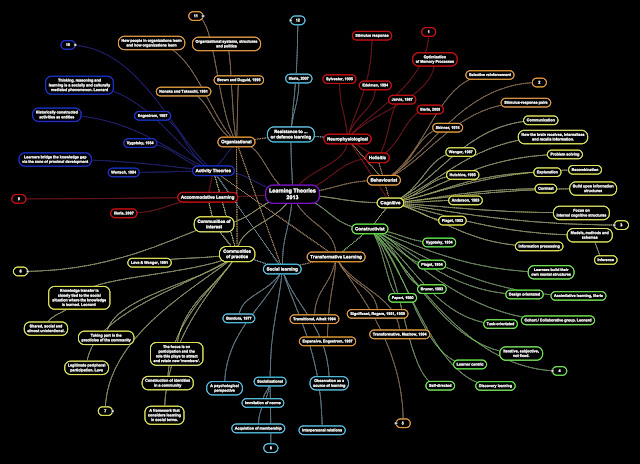
In the abstract we are told that ‘Although ICT resources are commonly expected to produce uniform benefits’ Tolmie (2001) Are they? And that, ‘they are necessarily employed within pre-existing contexts of educational and social activity’. Tolmie (2001)
When and where could a context NOT be pre-existing?? Something is, or is not. Context is an absolute.
Rather, what is that specific context. Otherwise this is tautology. It is like saying that electricity pylons go into an existing landscape. Isn’t this stating the obvious so that a gullible audience nod in agreement?
Tolmie (2001) talks of ‘unexpectedly diverse effects’. Unexpectedly or diverse? Surely not both.
Is this not something of an exaggeration? And in any case, such diverse responses should be either expected, or not presumed either way to be likely or unlikely to happen. It is very dangerous to pre-empt findings.
I visualise the introduction of new technology such as this as drops of ink in a pool of water in a stream - it has to compete with the mix that is already there, as well as its natural flow and other behaviours - leaking away into the land and evaporation for a start.
My conclusion based on reading the abstract is to: Think people above all else. Internal and external contexts are fluid and based on responses too and feelings.
It is all complex, and more to do with the brains of the individuals than simply their context . Everything can and should be measured in some way, from an agreed benchmark, to monitor, track then analyse. It is far more complex.
Take any class, habituated by the classroom, the people around us and the pattern and behaviour of the teacher … especially on a warm Friday afternoon, no wonder the mind wanders. Just because a person is physically in a classroom, even participating in a task, does not mean that much is going in if they are dreaming of the weekend or Fiona Henderson from the girl’s school down the road …
The expression ‘oversimplified’ used by Tolmie (2001) is a) hyperbole b) a value judgment.
Better ‘simplified’, preferably qualification of the term - simplified as in ‘clipped or contained’ that parameters are created because of the remit of the funding process. You are not able to ‘look outside the box’ as only that which takes place in the box is funded. There needs to be some of one and some of the other - research based on ‘tackling circumscribed needs’ while at the same time research that has an open brief and is open ended - that stands back to see the wood for the trees, rather than, to continue the metaphor, to examine only one kind of tree in the woods in order to avert the ‘mentality of one-stop resources’ mentioned by Oliver & Conole (1998)
How else do you address improving a situation other than by identifying the problems?
Anything else is misguided (literally), or indulgent. Far worse, in the NHS, and Post Office and Banking System have been wholesale computing systems that really were alien and universal.
Change management. Everyone has a point. Time to listen and involves matters most. The psychology of innovation. Resistance is despised. (Robinson et al., 1998)
Making the wrong assumptions that blame the teachers rather than the technology - which is a catalyst for complexity, rather than a tool for conformity.
Evaluation work also rarely does more than examine the explicitly intended effects of ICT, and so fails to identify unintended or serendipitous repercussions that may actually be a critical aspect of its impact (Jones, 1998).
But the entire point and context of an exam is to remove such context in the surroundings by placing the student in ‘exam conditions’ in a neutral space, where parameters of time and context are controlled and aim to be common to other students and impartial.
Surroundings mean different things to different people. It is naive and deterministic to think that people are so easily governed by their context. The individual over the surroundings. Unless we think students are like a uniform tribal grouping.
I'm through the reading and taking it further - reading the original paper to see if my concerns and amusement are justified.
I find the gender difference uninsightful and unhelpful - we know this anyway. Men and woman are different physiologically - which includes the brain where there are various documented differences especially between the differing amount of grey and white matter and the concentration of neurones and close connections in women compared to men. But the differences between men and women are not black and white (and their are not racial differences whatsoever) ... within these differences there is considerable variety.
Now add each person's context - which for me starts a few months after conception and every possible influence since - the same chaos theory that says that when a butterfly beats its wings in the Brazilian Jungle there is a typhoon in Malaysia will suggest that that marshmallow your grandmother gave you on Christmas day when you were six while watching Jimmy Saville introduce the Chart Show will influence how you respond to the 14 year old boy you have been paired up with in a physics class who offers you a handful of mini-marshmallows by way of 'making friends' who in turn is nervous about this strange but beautiful creature who he hasn't noticed all year but rather fancies even though his older brother has his eye on her - what was that the teacher said checking the trajectory of your balls on the computer ?????
The wrong approach was taken, though the theory throws up some interesting questions
I will change my opinion as I go through my notes but my current stance is that a quantitative before and after study requires many hundreds of participants in a randomised controlled trial and the gender differences are a distraction - far better to have administered questionnaires before and after and drawn upon each students SATS results or some such to get some sense of where they were coming from in relation to physics.
More interesting pairings would be like-minds and enemies - really. A couple of buddies having a laugh might learn less than a pair who can't stand each other, or another pair who are rivals.
Have I been watching too many teen movies? Probably.
Already I have a script in my head based on Tolmie in which far from being the less talkative, the FM pairs are chatting away to themselves (in their heads, written and delivered as stream of consciousness voice over), communicating in subtle ways through body language and as a result actually communicating more, not less than the ones who won't shut up - and who may be playing up to the research conditions.
This is the other fundamental humdinger of a problem - these students are being tested under 'lab conditions'.
My memories of teenager physics classes are more akin to St.Trinian's with boys. I even have a diary to call upon which I may look at just to get me into the role. I have a household of teenagers and another five nephews and nieces in this age bracket if I need to be reminded of what it is (and was) like.
Oddly enough, work is often the last thing on their minds. Which is why homework is so important - fewer potential distractions.
This will be less than hearsay in due course - I am also refreshing what it was and is like to be a teenager through some additional reading. Problem is my daughter senses that I am observing her from time to time.
I'm just asking myself the same question I asked when she was born, 'what is going on in there?' - but in a quasi-academic rather than father-daughter way.
Researchers make the mistake of believing that their intervention - in this case using a computer to support a physics class by trying to prompt discussion - is going to make some measurable difference.
Can they not see the bigger picture, and how vast it is?
If each human brain has as many neurons in it as the visible galaxy - 98 billion, and each brain though similar, is connected in different ways, by gender but essentially by genetics, with every remembered moment of waking and sleeping life in between. This is why, to have something measurable, researchers taken to the lab and until recently would have stuck with sea-snails, rats and in the past cats and primates … while gradually observation and measurement of electro-chemical activity in the human brain has become possible.
When it comes to exams surely examiners know that the response to a unique set of questions in an exam, certainly at undergraduate level, if not at post compulsory level, will test the student’s ability to construct a response both from what they know, and what they have to surmise.
REFERENCE
Jones, C. 1998 Evaluating a collaborative online learning environment Active Learning
Oliver, M. & Conole, G. (1998) Evaluating communication and information technologies: a toolkit for practitioners. Active Learning, 8,3–8.
Robinson, H., Smith, M., Galpin, F., Birchall, D., Turner, I. (1998) As good as IT gets: have we reached the limits of what technology can do for us? Active Learning, 9, 50–53.
Tolmie, A. (2001), Examining learning in relation to the contexts of use of ICT. Journal of Computer Assisted Learning, 17: 235–241. doi: 10.1046/j.0266-4909.2001.00178.







